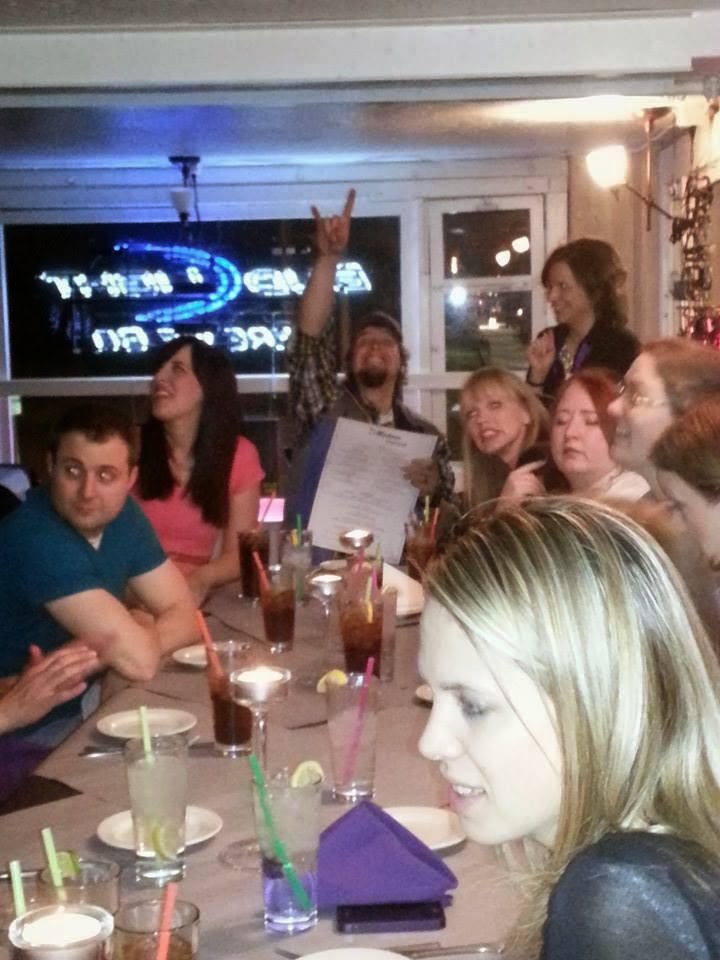We're all eating.
Also, I promised some of the kids I would post my notes for my writing Humor class on here:
Writing Humor
3 Types of Writing Humor: EYE
ROLLERS, AC/DCS, EVERYTHING ELSE
Eye Rollers –
§
Often involve potty humor or bodily functions
§
Have very little seriousness involved, if any.
§
Every character supplies the humor, including
and most especially the narrator. – The narrator is not simply there to move
the story along. Your narrator needs to have a strong voice and is very much
involved in the story itself. In terms of Eye-Rollers, Often the narrator will
point out the ridiculousness of the story and the lack of intelligence
displayed by the characters involved.
§
The ability to sketch somewhat discernible
pictures is a bonus.
§
Not intended for riveting plot twists. This is a
great place to introduce slapstick.
Tips for Writing an Eye Roller
§
Allow yourself absolute freedom – no restraints.
The more ridiculous the better. If you need help starting your story, think of
the most unusual situation your character could be in, then think of the most
bizarre reaction.
§
If you’re struggling to make the narrator just
as zany and ridiculous as the other characters, write the story in first person.
§
Critical piece, don’t mess up and forget to make
your main character funny.
Activity – Take your most
embarrassing experience and write it with 1,000 words or less. You want to make
sure all the key hilarious elements are present, but remove the fluff. Don’t
try to write too much of the setting, the description, or the other characters
involved. Draw stick figures to
emphasize the points.
AC/DCs - Action/Comedies-Drama/Comedies
– For the majority of this room, this will be where you land.
§
Humor shares the spotlight with another theme
(action, drama, horror, fantasy, romance)
§
Humor enhances the ideas in the story. You’re
reading because of the initial theme, but you keep reading because of the
laughter that ensues page after page.
§
Not every page needs a zinger, but there has to
be a hearty supply of laughs within.
§
This is where we find the great comedic
sidekicks of the literary world. More to come on this later.
§
Humor is used to keep these stories on the
lighter side. Most Middle Grade, with the exception of a few titles will have
to stay lighter rather than darker.
Tips for Writing AC/DCs
§
Allow your Main Character to have some humorous
attributes. Witty, Snarky, Clumsy
§
Lead out with a funny chapter. A funny scenario
or sequence.
§
Try a new angle on something or new concept.
§
There needs to be problems in your story and
conflict that happens to your character. Don’t automatically make your
character a victim. Give them a sense of humor to handle the situations.
In Middle Grade, don’t always
make the conflict dire. Add scenes of surprise to allow the characters a chance
to show their funny reactions. This will endear the character to the reader.
When in doubt, always add a
secondary character to be the comic relief.
Main Characters have to shoulder
the load of the story. The seriousness, the consequences, the conflict. It all
falls onto the main character and you need one person to be there through it
all. Because of that, there will be large sequences or chunks of your book
where the main character will lose their sense of humor at times. Someone has
to make the difficult decisions. Someone has to be accountable. If your main
character never makes a difficult choice or just allows the problems to happen
and never takes a stand, the reader won’t connect with them and your book will
lack of substance. Therefore, this is why I strongly urge everyone to add at
least one if not more secondary characters who share some of the spotlight with
your main character.
Sidekicks
Sidekicks allow you to dump a ton
of humorous situations into your story while maintaining the integrity of your
main character.
Sidekicks don’t have to follow
the same rules as your main character. They can be snarky, or obnoxious
throughout the story.
If your main character were to
have that flighty or obnoxious of an attitude, the reader would lose respect.
This is not the case with Sidekicks. They actually earn more respect from the
reader. Readers love them for their attitudes. They give the reader a safety
net for when things get thick, they always have someone to lighten the mood.
Everything Else
·
Humor is used to create interest in a key
character, transforming them from cardboard to complex.
·
The laughs are not what you signed up for, but
provide a nice surprise.
·
The humor is embedded. More difficult to find.
| 


1 comment:
This is really great information about teen boot camp.
Post a Comment